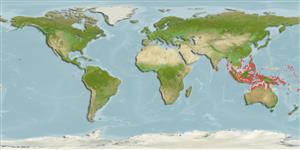Environment: milieu / climate zone / depth range / distribution range
Ecologia
marino associati a barriera corallina; distribuzione batimetrica 8 - 25 m (Ref. 9710). Tropical; 25°N - 18°S
Western Pacific: Japan to Western Australia and the Solomon Islands.
Size / Peso / Age
Maturity: Lm ? range ? - ? cm
Max length : 10.0 cm TL maschio/sesso non determinato; (Ref. 9710)
Spine dorsali (totale): 1 - 2; Raggi dorsali molli (totale): 29-33; Spine anali 0; Raggi anali molli: 25 - 30. Dark brownish green to grayish green head and back, lower portions noticeably whitish; dark brown to pale orange iris; dark brown lips. Caudal fin membranes usually orange anteriorly, dusky posteriorly; other fins clear; spinous dorsal similar to body color. Pelvic fin rudiment moderate in size, broadly attached to posterior margin of ventral flap. Midbody scales variable in size. Scale rugosities in males usually develop at about 50 mm SL. Varies considerably with respect to squamation, coloration, fin-ray counts and max. size across its range.
Secretive species found in lagoon and protected seaward reefs (Ref. 9710, 48637), often in silty conditions. Solitary (Ref. 90102). Sometimes seen deep inside branching corals (Ref. 48637). Has been from deeper water by trawls.
Life cycle and mating behavior
Maturità | Riproduzione | Deposizione | Uova | Fecundity | Larve
Hutchins, J.B., 1986. Review of the monacanthid fish genus Pervagor, with descriptions of two new species. Indo-Pac. Fish. (12):35 p. (Ref. 527)
IUCN Red List Status (Ref. 130435)
Threat to humans
Harmless
Human uses
Informazioni ulteriori
Nomi ComuniSinonimiMetabolismoPredatoriEcotossicologiaRiproduzioneMaturitàDeposizioneSpawning aggregationFecundityUovaEgg development
BibliografiaAcquacolturaProfilo di acquacolturaVarietàGeneticaElectrophoresesEreditarietàMalattieElaborazioneNutrientsMass conversion
CollaboratoriImmaginiStamps, Coins Misc.SuoniCiguateraVelocitàModalità di nuotoArea branchialeOtolithsCervelliVista
Strumenti
Special reports
Download XML
Fonti Internet
Estimates based on models
Preferred temperature (Ref.
123201): 27.8 - 29.3, mean 28.8 °C (based on 1722 cells).
Phylogenetic diversity index (Ref.
82804): PD
50 = 0.5039 [Uniqueness, from 0.5 = low to 2.0 = high].
Bayesian length-weight: a=0.01995 (0.00943 - 0.04220), b=2.93 (2.75 - 3.11), in cm total length, based on LWR estimates for this (Sub)family-body shape (Ref.
93245).
Trophic level (Ref.
69278): 2.9 ±0.4 se; based on size and trophs of closest relatives
Resilienza (Ref.
120179): Alto, tempo minimo di raddoppiamento della popolazione meno di 15 mesi (Preliminary K or Fecundity.).
Fishing Vulnerability (Ref.
59153): Low vulnerability (10 of 100).
Nutrients (Ref.
124155): Calcium = 98.7 [43.0, 256.3] mg/100g; Iron = 0.935 [0.421, 2.194] mg/100g; Protein = 17.9 [15.6, 20.1] %; Omega3 = 0.114 [0.051, 0.237] g/100g; Selenium = 27.5 [12.8, 64.3] μg/100g; VitaminA = 73 [20, 277] μg/100g; Zinc = 1.83 [1.15, 2.93] mg/100g (wet weight);
